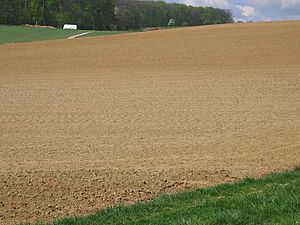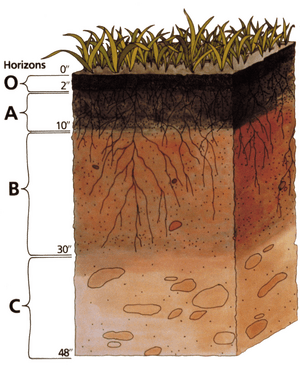Soil facts for kids

Soil is the loose, top layer of Earth. It's like a thin blanket covering our planet. Soil is a mix of many things. It has tiny pieces of rock and minerals. It also holds water and air. Plus, soil is full of living things and dead things. We call these living and dead parts "organic matter". Soil is super important for all life on Earth.
Soil helps plants grow because it holds water and nutrients. It gives plants a place to anchor their roots. This helps them stand tall and get the sunlight they need. Many tiny living things like fungi and bacteria also live in the soil. They eat dead plants and animals. This process breaks down the material. It turns it into food for plants, which are called nutrients.
Lots of animals dig into the soil to make their homes. Large animals use soil to build dens for sleeping and having babies. Smaller animals, like earthworms, spend most of their lives in the soil. Earthworms are famous for making soil better. The holes they dig let air and water move through the soil easily.
Soil also has many tiny microorganisms. These are living things too small to see without a microscope. Many of them eat the organic material in the soil. They use oxygen and release carbon dioxide. They also release mineral nutrients back into the soil.
Soil looks different in different places around the world. This is because the climate and the types of rocks vary. Soils are often thicker where ice sheets once covered the ground. This happened during the Pleistocene ice ages. The moving ice sheets ground rocks into a fine powder.
Contents
What Is Soil Made Of?
Soil is made of four main things. Think of it like a recipe!
- It has tiny pieces of rock. These rocks are made of different minerals.
- It has dead and living things. We call this "organic matter" or humus.
- It has water.
- It has air.
What makes up a typical loam soil by volume Water (25%) Gases (25%) Sand (18%) Silt (18%) Clay (9%) Organic matter (5%)
Soil contains rock pieces that have been broken down. This happens because of wind, rain, sun, and snow. These rocks are made of minerals. Some minerals can dissolve in water. These dissolved minerals can then be used as food by plants. Soil also has dead and living things, which is the organic matter. When a plant dies, tiny animals and bacteria in the soil eat it. What's left after they eat is called humus. When the bacteria die, the plant food (minerals) goes back into the soil. Plant food is also called a "plant nutrient." There are many kinds of plant nutrients.
Soil has many empty spaces, about half of its total volume. These spaces are filled with water and air. Water can easily enter these spaces. Plants drink this water, along with the minerals in it. Plant roots also need air to live. If roots don't get air, they will die. If the roots die, the whole plant will die. A dead plant then gets eaten by bacteria and becomes plant nutrients again.
There are many types of soil. Each type has different amounts of big and small rocks, plus some humus. If the rocks in soil are as big as your fingers, we call them "gravel." Smaller rocks are called sand. Even smaller rocks are called silt. The very, very smallest rocks are called clay. You can see sand with your eyes. Sand feels rough between your toes. Silt is so small you might need a lens to see it. Silt feels smooth between your toes. Clay is too small to see even with a lens. You need a big microscope to see clay. Clay feels slippery between your toes. Most soils have a mix of these small rocks. The three best types of small rocks for soil are sand, silt, and clay.
Every soil has different amounts of sand, silt, and clay. This mix is called the "texture" of the soil, or "soil texture." A soil with a lot of sand is called "sandy soil texture." If it has a lot of silt, it's a "silt soil texture." A soil with a lot of clay is a "clay soil texture." Farmers like to grow food in the best soil. The best soil often has about half sand, some silt, and a little clay. The organic matter in the soil is not counted when we talk about soil texture. Only the rock pieces are counted. Soil texture is very important for how plants grow.
Soil Clumps (Structure)
The smallest parts of soil are sand, silt, and clay. These tiny parts can stick together to form larger pieces called "clumps" or "aggregates." Humus, clay, and minerals in the soil act like glue. This "glue" makes the sand, silt, and clay stick together to form clumps. These clumps can have different shapes. Some soils have small, round clumps. Other soils have large, hard, flat clumps.
Soil with small, round clumps is usually the best. It allows air and water to move through easily. A little bit of "glue" is good. If there's just enough glue, the soil will have space for water and air, and it will be soft. If there's too much glue, the soil can become hard. If there's no glue, there won't be enough space for air and water. A soil with no spaces is not healthy for plants. Worms in the soil make a slippery glue. When worms dig holes, they leave some of this glue behind. Plant roots also create spaces in the soil. When the roots die, they leave holes too.
Soil Layers (Horizons)
Soil has a "soil texture" (sand, silt, and clay) and organic matter mixed in. But weather also changes the soil. It's cold near the Earth's north and south poles. It's hot near the equator. Some places get a lot of rain, while others get none. Hot and wet weather creates one kind of soil. Cold and dry weather makes another. Rainwater can make small things in the soil move downwards. When these things get stuck, they form a layer in the soil. If you dig down, you might find many layers. These layers can have different colors. They can also have different "soil textures." The top part might have a lot of humus and sand. Below that, there might be a layer of silt. Below that, there could be a layer of clay.
Sand usually stays on top because its pieces are larger. Silt moves down a little with water and forms a layer because it's smaller. Clay can go even lower with water because it's the smallest. So, sand makes one layer, silt another, and clay another. Humus can also move down with water and form a layer. Silt, clay, and humus can move down because of the spaces in the soil. However, they can also fill up these spaces. When the spaces are closed, it's hard for air to get into the soil. Plant roots don't grow well where there's no air. When we dig down, we see these distinct layers.
We call these layers "soil horizons." The very top layer might be about an inch (25mm) thick. We call this the "O" horizon or sometimes "topsoil." The next layer down is the "B" horizon. Below that is the "C" horizon. The very bottom layer has many rocks and is called the bedrock or "R" horizon. Deep down, there is always bedrock, though you might have to dig a mile (or a kilometer) or more to reach it. When soil dries, it can shrink and form cracks. Soil from the top layer might fall into these cracks. This mixes the layers. There might be many types of soil where you live, or only one. Different rocks create different soil textures. Different weather also changes these soil textures. That's why there are so many different soils all over the world.
Related pages
More Images
-
Surface-water-gley soil in Northern Ireland.
See also
 In Spanish: Suelo para niños
In Spanish: Suelo para niños






